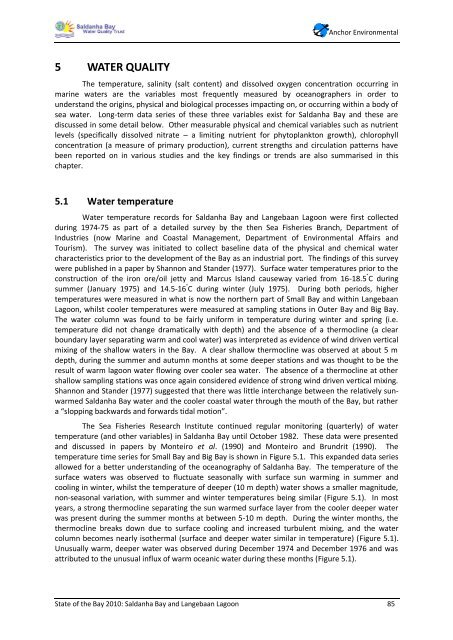State of the Bay Report 2010-Final - Anchor Environmental
State of the Bay Report 2010-Final - Anchor Environmental
State of the Bay Report 2010-Final - Anchor Environmental
Create successful ePaper yourself
Turn your PDF publications into a flip-book with our unique Google optimized e-Paper software.
5 WATER QUALITY<br />
<strong>Anchor</strong> <strong>Environmental</strong><br />
The temperature, salinity (salt content) and dissolved oxygen concentration occurring in<br />
marine waters are <strong>the</strong> variables most frequently measured by oceanographers in order to<br />
understand <strong>the</strong> origins, physical and biological processes impacting on, or occurring within a body <strong>of</strong><br />
sea water. Long-term data series <strong>of</strong> <strong>the</strong>se three variables exist for Saldanha <strong>Bay</strong> and <strong>the</strong>se are<br />
discussed in some detail below. O<strong>the</strong>r measurable physical and chemical variables such as nutrient<br />
levels (specifically dissolved nitrate – a limiting nutrient for phytoplankton growth), chlorophyll<br />
concentration (a measure <strong>of</strong> primary production), current strengths and circulation patterns have<br />
been reported on in various studies and <strong>the</strong> key findings or trends are also summarised in this<br />
chapter.<br />
5.1 Water temperature<br />
Water temperature records for Saldanha <strong>Bay</strong> and Langebaan Lagoon were first collected<br />
during 1974-75 as part <strong>of</strong> a detailed survey by <strong>the</strong> <strong>the</strong>n Sea Fisheries Branch, Department <strong>of</strong><br />
Industries (now Marine and Coastal Management, Department <strong>of</strong> <strong>Environmental</strong> Affairs and<br />
Tourism). The survey was initiated to collect baseline data <strong>of</strong> <strong>the</strong> physical and chemical water<br />
characteristics prior to <strong>the</strong> development <strong>of</strong> <strong>the</strong> <strong>Bay</strong> as an industrial port. The findings <strong>of</strong> this survey<br />
were published in a paper by Shannon and Stander (1977). Surface water temperatures prior to <strong>the</strong><br />
construction <strong>of</strong> <strong>the</strong> iron ore/oil jetty and Marcus Island causeway varied from 16-18.5 ° C during<br />
summer (January 1975) and 14.5-16 ° C during winter (July 1975). During both periods, higher<br />
temperatures were measured in what is now <strong>the</strong> nor<strong>the</strong>rn part <strong>of</strong> Small <strong>Bay</strong> and within Langebaan<br />
Lagoon, whilst cooler temperatures were measured at sampling stations in Outer <strong>Bay</strong> and Big <strong>Bay</strong>.<br />
The water column was found to be fairly uniform in temperature during winter and spring (i.e.<br />
temperature did not change dramatically with depth) and <strong>the</strong> absence <strong>of</strong> a <strong>the</strong>rmocline (a clear<br />
boundary layer separating warm and cool water) was interpreted as evidence <strong>of</strong> wind driven vertical<br />
mixing <strong>of</strong> <strong>the</strong> shallow waters in <strong>the</strong> <strong>Bay</strong>. A clear shallow <strong>the</strong>rmocline was observed at about 5 m<br />
depth, during <strong>the</strong> summer and autumn months at some deeper stations and was thought to be <strong>the</strong><br />
result <strong>of</strong> warm lagoon water flowing over cooler sea water. The absence <strong>of</strong> a <strong>the</strong>rmocline at o<strong>the</strong>r<br />
shallow sampling stations was once again considered evidence <strong>of</strong> strong wind driven vertical mixing.<br />
Shannon and Stander (1977) suggested that <strong>the</strong>re was little interchange between <strong>the</strong> relatively sunwarmed<br />
Saldanha <strong>Bay</strong> water and <strong>the</strong> cooler coastal water through <strong>the</strong> mouth <strong>of</strong> <strong>the</strong> <strong>Bay</strong>, but ra<strong>the</strong>r<br />
a “slopping backwards and forwards tidal motion”.<br />
The Sea Fisheries Research Institute continued regular monitoring (quarterly) <strong>of</strong> water<br />
temperature (and o<strong>the</strong>r variables) in Saldanha <strong>Bay</strong> until October 1982. These data were presented<br />
and discussed in papers by Monteiro et al. (1990) and Monteiro and Brundrit (1990). The<br />
temperature time series for Small <strong>Bay</strong> and Big <strong>Bay</strong> is shown in Figure 5.1. This expanded data series<br />
allowed for a better understanding <strong>of</strong> <strong>the</strong> oceanography <strong>of</strong> Saldanha <strong>Bay</strong>. The temperature <strong>of</strong> <strong>the</strong><br />
surface waters was observed to fluctuate seasonally with surface sun warming in summer and<br />
cooling in winter, whilst <strong>the</strong> temperature <strong>of</strong> deeper (10 m depth) water shows a smaller magnitude,<br />
non-seasonal variation, with summer and winter temperatures being similar (Figure 5.1). In most<br />
years, a strong <strong>the</strong>rmocline separating <strong>the</strong> sun warmed surface layer from <strong>the</strong> cooler deeper water<br />
was present during <strong>the</strong> summer months at between 5-10 m depth. During <strong>the</strong> winter months, <strong>the</strong><br />
<strong>the</strong>rmocline breaks down due to surface cooling and increased turbulent mixing, and <strong>the</strong> water<br />
column becomes nearly iso<strong>the</strong>rmal (surface and deeper water similar in temperature) (Figure 5.1).<br />
Unusually warm, deeper water was observed during December 1974 and December 1976 and was<br />
attributed to <strong>the</strong> unusual influx <strong>of</strong> warm oceanic water during <strong>the</strong>se months (Figure 5.1).<br />
<strong>State</strong> <strong>of</strong> <strong>the</strong> <strong>Bay</strong> <strong>2010</strong>: Saldanha <strong>Bay</strong> and Langebaan Lagoon 85

















